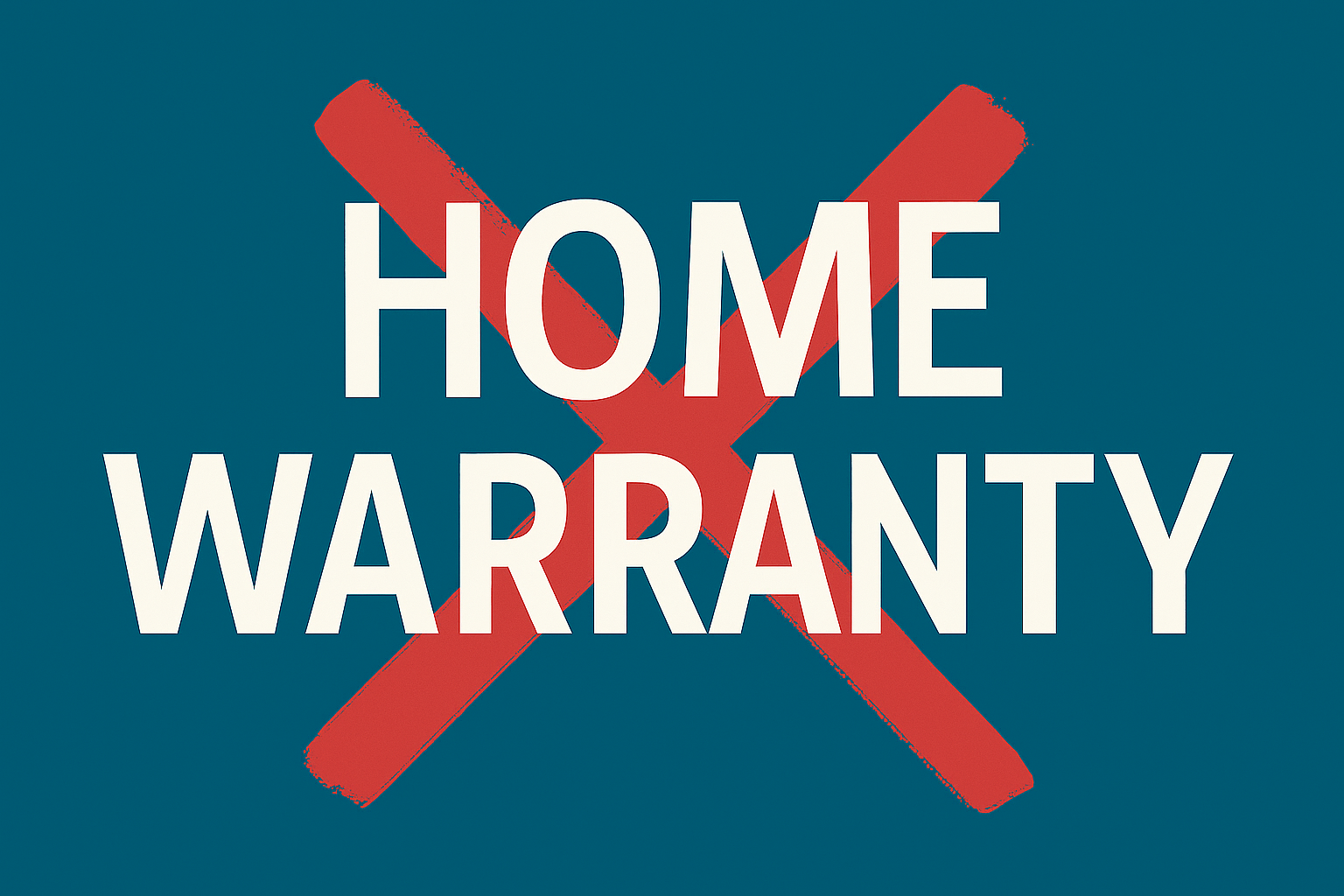When homeowners hear the phrase home warranty, it sounds like peace of mind, a safety net when something expensive breaks. But in the world of property management, home warranties rarely deliver what they promise. In fact, they often create more problems, cost more money, and leave residents frustrated when major systems fail.
At Cissell Management Company, we’ve seen this play out time and time again, especially with HVAC systems during the hottest months of the year.
That’s not to say home warranties never have a place. They can be useful when selling a property, giving a buyer short-term peace of mind during that first year of ownership. But they’re not designed to be a long-term solution for ongoing maintenance or major repairs, especially when residents are living in the home and relying on those systems every day.
A Quick Note on What We Mean by “Home Warranty”
When we talk about home warranties in this post, we’re referring to third-party service contracts like American Home Shield, Choice Home Warranty, or Select Home Warranty. These companies sell coverage plans that handle system and appliance repairs after a breakdown.
They are not the same thing as a builder’s warranty, which covers structural or workmanship defects in new construction for a set period after the home is built. Builder warranties are legitimate protections tied to the construction process. Third-party home warranties, on the other hand, are optional plans that sound convenient but often fall short for rental properties.
The Real Problem With Home Warranties
Home warranties are built for owner-occupied homes, not rentals. The process that feels like a minor inconvenience for a homeowner becomes a major liability when a resident is living in the property.
Here’s what typically happens when a property owner relies on a home warranty for repairs:
- Slow response times: The warranty company takes days to assign a technician. It’s completely normal for no one to even look at the issue for five days or longer.
- Subpar contractors: Warranty companies pay vendors low rates, so they tend to use whoever will take the job, not necessarily the best or most reliable technicians. We don’t know of any reputable vendors in Oxford who will work with home warranty companies. Because of that, warranty companies usually have to bring in vendors from the Memphis area, which leads to even longer delays. The vendors who take warranty work are typically the ones who need the business, not the ones known for quality or quick response times.
- Cheap, short-term repairs: Warranty vendors are focused on getting the system running again, not on long-term solutions. They approve the least expensive repair possible, even if it only lasts a few months.
- Coverage loopholes: Anything considered “maintenance,” like cleaning coils, isn’t covered, but those items are often the very things that cause system failure.
The result? A resident can be without air conditioning for several days in 90-plus-degree heat while waiting for someone to show up, and the property owner ends up paying for a temporary fix that doesn’t actually solve the problem.
A Real Example: When Quick Action Mattered
Recently, a resident reported an AC outage after business hours on a Thursday evening.
At the time, we didn’t know the property owner had a home warranty. Because of that, our team moved forward and had a technician on-site by Friday morning. When he saw the repair would take time, he installed a temporary cooling unit so the residents wouldn’t be without air.
Once the owner notified us that she had a home warranty and reported the claim, the warranty company didn’t send anyone out until Tuesday afternoon. That delay, nearly five days, is typical with home warranty work. If the system had needed replacement, it could have easily taken 10 days or even two weeks before the repair was complete.
By comparison, our technician could have had a brand-new system installed by the time the home warranty company’s technician even arrived to evaluate the issue.
And this isn’t a one-time experience. This is the same pattern we’ve seen over the years with home warranty companies, whether it’s HVAC, plumbing, or appliance repairs. The delays, poor communication, and low-quality service are consistent, no matter the type of work being done.
That’s simply not acceptable when people are living in the home, especially in 90-degree weather.
Why These Repairs Don’t Make Financial Sense
In this case, the technician found the compressor wasn’t starting, the coil was completely clogged, and the system, 16 years old, was at the end of its life. The coil was clogged because the owner never changed the air filter while living in the home, which caused the system to run inefficiently and overheat the compressor over time.
Our technician explained that while he might be able to get the unit running temporarily by installing a hard start kit (around $400–$600), it wouldn’t fix the underlying issue. The coil still needed to be cut out, cleaned, and reinstalled ($1,200–$1,500), and even then, the compressor would likely fail soon after ($2,000–$2,500). Altogether, that would be roughly $4,000 in short-term repairs on a 16-year-old system with no warranty and no long-term reliability.
The home warranty company, on the other hand, approved only the cheapest possible repair. They installed a hard start kit to get the system running again but did nothing to clean the coil or address the root problem that caused the compressor to fail in the first place. Their goal was simply to restore operation so they could mark the claim as “resolved.”
That means the system is still clogged, still running inefficiently, and still likely to fail again. To make matters worse, the warranty company could deny future compressor coverage unless the coil is properly cleaned, an additional $1,200–$1,500 expense that still has to be done to keep the warranty valid.
Replacing the system outright would have been the smarter financial move. A new unit would come with a 10-year parts and labor warranty, operate efficiently, and eliminate the ongoing risk of repeated failures.
A Different Standard for Rental Properties
There’s also a big difference between how you handle repairs in your own home and how they should be handled in a rental property.
When you live in a home you own, you might be willing to wait several days for a cheaper repair or tolerate a little discomfort. But when someone else is paying to live there, that approach doesn’t work.
A rental property is a business, and in business, delayed maintenance hurts your reputation, your bottom line, and your relationship with your residents. Fast, professional repairs aren’t about convenience; they’re about protecting your investment, maintaining resident satisfaction, and preventing costly turnover.
The Bigger Picture: Why Home Warranties Cost More
The truth is, home warranties aren’t built to save you money. They’re built to make money for the warranty company. Every time you pay your annual fee, you’re betting that you’ll need more in repairs than you pay in premiums. But that’s not how these companies stay in business.
Warranty companies are highly profitable, which means they spend less on your repairs than you pay them each year. According to an analysis by Checkbook, the parent company of American Home Shield reported $979 million in revenue and $532 million in service costs over a nine-month period. That means customers received about 54 cents in services for every dollar they paid. If you pay $600 a year for an American Home Shield warranty, they spend, on average, only about $324 a year on your repairs.
- You pay annual fees (often $600–$900) plus a service fee each time a vendor comes out.
- You get delays and poor workmanship that can cause additional damage or resident frustration.
- You lose control over who works on your property, and quality vendors in Oxford often refuse warranty work altogether.
After 18 years in property management, we’ve never seen an owner come out ahead with a home warranty. Not once.
What About When Home Warranties “Work”?
Every so often, someone shares a story about their home warranty paying off. For example, one homeowner on a message board said that after buying a $500 policy, both their air conditioner and water heater failed within a year, and the warranty company covered both.
And that’s true. Sometimes you get lucky.
But that’s the exception, not the rule. Home warranties operate like casinos. They rely on the odds being in their favor. For every lucky payout story, there are hundreds of property owners who’ve paid premiums for years and received little or nothing back.
So while a warranty might occasionally “work,” the system as a whole is designed so that most people won’t come out ahead.
The Better Solution
As a professional property management company, our goal is to protect both your property and your residents and to do it efficiently.
Here’s what we do instead:
- We work with trusted local vendors who respond quickly, even on weekends.
- We prioritize long-term repairs and replacements that actually save owners money over time.
- Some vendors offer financing options for large expenses, so owners don’t have to rely on home warranty programs to handle major repairs or replacements.
When systems reach the end of their lifespan, replacing them isn’t just about spending money; it’s about taking care of the people living in the home. Maintenance not being performed in a timely manner is the number one reason residents choose to move. And when that happens, owners end up paying even more in turnover costs — repairs, painting, and vacancy loss — all of which could have been avoided with prompt, proactive maintenance. A reliable system keeps residents comfortable, prevents emergency calls, and protects your property from further damage. It’s one of the best ways to invest in both your residents’ experience and your property’s long-term health.
Final Thoughts
If you own a rental property, a home warranty may sound appealing, but it’s not designed for this business. In practice, it often means slower service, frustrated residents, and more money out of your pocket in the long run.
Our job is to make ownership as smooth and stress-free as possible, and that means helping you make decisions that protect your investment instead of patching it.


